
The 450,000-square-foot InterContinental Hotel and Conference Center at the Cleveland Clinic in Cleveland, OH, was reconstructed with the use of natural stone as both interior and exterior features. IGM of Columbus, OH, supplied much of the stone for the project, which called for custom fabricated marble and granite, plus 60,000 square feet of installed marble tile. Located in the main lobby is a 38- x 16-foot oval mosaic depicting a 17th century Old World map.
In addition to adding new medical buildings to the Cleveland Clinical Foundation's campus, the owners recently decided to reconstruct the clinic's hotel facility as well. The 450,000-square-foot facility - formally named the InterContinental Hotel and Conference Center at the Cleveland Clinic - was rebuilt using natural stone for both interior and exterior features. IGM of Columbus, OH, supplied much of the stone for the project, which called for custom-fabricated marble and granite, plus 60,000 square feet of installed marble tile.
The facility includes 300 luxury guest rooms, 29 guest suites, a 500-seat amphitheater, a ballroom, three restaurants and the only conference center of its kind in the country
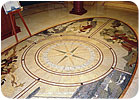
A second mosaic was modeled after an Old World-style compass, and its 22- x 11-foot design features 1,500 pieces of stone, which range from less than 1 square inch to several feet wide.
The overall design goal for the renovation was to maintain the upscale reputation of the InterContinental Hotel chain, and also to bolster the Cleveland Clinic's reputation as one of the premier medical facilities in the world. Part of this design called for the extensive use of stone for the flooring throughout the hotel as well as for the guest rooms. Beach marble from IGM was selected for various features throughout the hotel, including the lobby and elevator floors. IGM also supplied Beach marble - which was quarried in Indonesia - for the curved grand staircase located near the main entrance of the hotel. According to Kevin Macko of ArsenaStone - a division of the Acme Arsena Co. Inc. - of Macedonia, OH, who served as the Project Manager for all interior stone as well as a portion of the exterior, “terrorist activity at the time caused some shipping delays and overall anxiety due to the magnitude of the quantity required from there.†Macko also said that alternate stones were considered before he was released to place the order for the Beach marble.
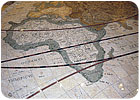
For the murals, 43 types of granite - in 3 ¼-inch-thick pieces - were brought in from countries, including Italy, China, Brazil, Russia, Finland, Canada, India, Sri Lanka, Norway, Portugal, the U.S.
and many countries in Africa.
Additionally, the flooring, walls and shower accessories in the guest rooms comprise a total of 50,000 square feet of 12- x 12- and 18- x 18-inch tiles of Beach marble, Rojo Alicante marble, Verde Empress marble and Jerusalem Bone limestone. The countertops throughout the guest rooms feature an array of stones, including Giallo Lite marble, Brown Pearl granite, Yellow Antico marble, Giallo Reale marble, Jura Beige and Santa Cecilia Dark granite.
Moving outside the hotel, the facade of the building is clad in alternating rows of Texas Pink and Radiant Red granite - supplied by Cold Spring Granite Co. of Cold Spring, MN - which were selected to complement the adjacent Clinic buildings.
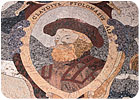
The mosaics were custom cut by Ceramic Technics, Ltd., of Alpharetta, GA, using a computerized waterjet saw to accurately shape each piece for the mural.
The fabrication process
Macko's responsibilities and decisions were critical in the months that led up to the completion of the project, according to ArsenaStone. The company decided that it was advantageous to have much of the stone produced at facilities near the stone quarries, and facilities in China, Brazil and Indonesia were used.Once the construction manager and the architect approved the drawings, the cutting and finishing of the stone began at these worldwide facilities. In order to meet the time-sensitive nature of the project, some of the stone fabrication was also completed at the ArsenaStone facility, according to the company. Such work included the fabrication of Rainbow onyx backlit panels at the lobby gallery and behind the lobby lounge bar, countertops for the Presidential Suite and VIP Suite, as well as the stone used in the restaurant and for fireplace surrounds.
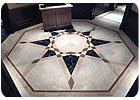
Marble from IGM was selected for various features throughout the hotel, including the lobby and elevator floors.
A few challenges arose regarding interruptions in the timeline, including dock strikes, last minute design changes and compaction of trades, as well as the typical logistical problems common to a project of this magnitude, according to ArsenaStone.
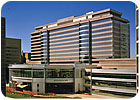
Stonework was also carried to the exterior, as the facade of the building is clad in alternating rows of Texas Pink and Radiant Red granite - supplied by Cold Spring Granite Co. of Cold Spring, MN.
The murals
One of the most noteworthy stone applications is the presence of two floor murals that depict ancient maps of the world. A total of 43 types of granite - in 3¼-inch-thick pieces - were brought in from countries around the globe, including Italy, China, Brazil, Russia, Finland, Canada, India, Sri Lanka, Norway, Portugal, the U.S. and many countries in Africa. All of the granite was shipped to Ceramic Technics, Ltd., of Alpharetta, GA, which used a computerized waterjet to accurately shape each piece for the murals.They were originally designed to contain 1,200 pieces in total, but during Macko's first trip to Ceramic Technics in Georgia, he reviewed the work in progress and realized that the murals would ultimately contain 3,600 individual pieces.
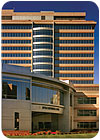
The exterior materials were selected to complement the adjacent Clinic buildings.
Completion of the cutting and delivery of the murals took more time than originally estimated, and some pieces needed resizing in the field, according to ArsenaStone, which added extra personnel to the installation teams and rearranged schedules in order to stick to the timeline. The murals took six workers a 2 ½-month period to construct.

The overall design goal for the renovation was to maintain the upscale reputation of the InterContinental Hotel chain, and also to bolster the Cleveland Clinic's reputation as one of the premier medical facilities in the world.
InterContinental Hotel and Conference Center
Cleveland, OH
Architect: Brennan Beer Gorman/Architects, New York, NY
Interior Design Consultant: Design Continuum, Cincinnati, OH
Construction Manager: Turner Construction Co., Cleveland, OH
General Contractor: ArsenaStone (a division of the Acme Arsena Co.), Macedonia, OH
Waterjet Medallion Fabricator: Ceramic Technics Ltd., Alpharetta, GA
Stone Suppliers: IGM, Columbus, OH (interior materials) Cold Spring Granite Co., Cold Spring, MN (Texas Pink and Radiant Red granite